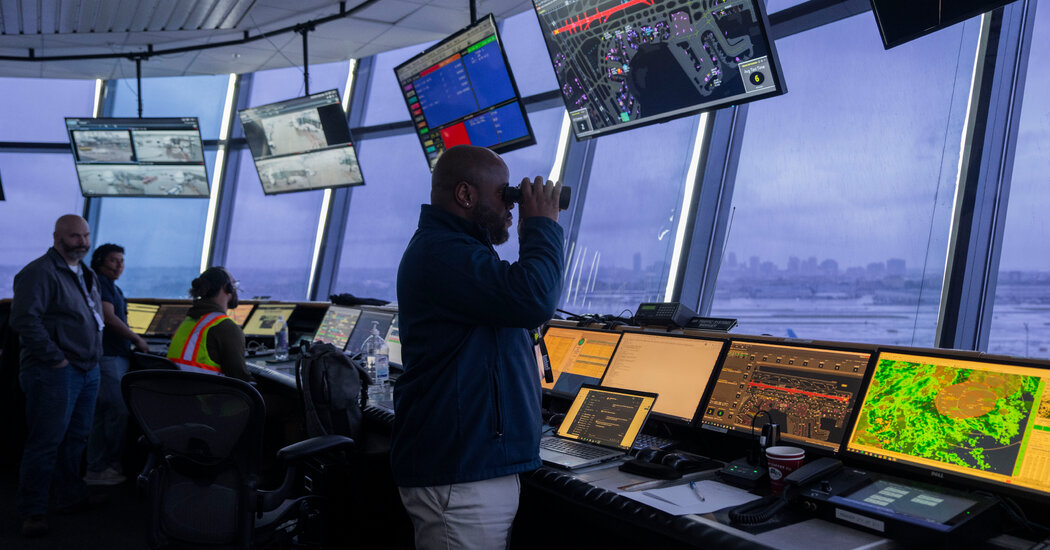It was less than two hours before United Airlines Flight 110 was scheduled to depart for London from Newark when Nikki Brooks got word that something was wrong.
A team delivering blankets and pillows for the overnight long-haul flight reported damage on a rear plane door around 4 p.m. on Thursday. A photograph showed what appeared to be a scratch that maintenance needed to inspect. So Ms. Brooks, a manager at the airline’s Station Operations Center at Newark Liberty International Airport, delayed the flight.
From a fifth-floor perch with views of Terminal C and the runways, Ms. Brooks and her colleagues make hundreds of decisions a day, about mechanical and medical issues or gate assignments — all to keep United’s operations smooth and ensure planes aren’t delayed.
If they do their jobs right, no one hears about the more than 600 flights a day that United operates at Newark, one of its hubs. Lately, keeping those planes on time has been harder to do.
A series of air traffic control technology outages and staffing shortages, along with runway construction, has created a sense of crisis at Newark among travelers. Delays and safety concerns early in the month drove away some fliers and prompted federal officials to fast-track desperately needed improvements. Now, to stem the disruption, the Federal Aviation Administration has limited the number of flights at Newark through most of the rest of the year.
On Thursday, Ms. Brooks and her colleagues were overseeing an early wave of Memorial Day travel, which kicks off the busy summer season nationwide.
The fortunes of the airport and United are tightly intertwined. The airline operates the vast majority of flights at Newark. And roughly 9 percent of seats that United fills on all its planes start or end their journeys here.
The recent disruptions peaked in early May, when air traffic control problems led United to cancel more than 12 percent of its flights at Newark, according to Cirium. But that has improved significantly in recent days. The airline canceled only 10 flights at Newark from Sunday through Thursday, less than 1 percent of its schedule.
Limiting delays, cancellations and other disruptions requires a high degree of vigilance, and calm, from United operations managers like Ms. Brooks.
After delaying the flight to London, she instructed gate agents to proceed with boarding anyway. It was a small gamble that the scratch was not a sign of something more serious, and that the problem could be resolved quickly. (It was.)
The London flight departed just after 6, a delay of less than 45 minutes. After that, Ms. Brooks turned her attention to the flights departing from the dozen or so other gates she was monitoring during her 10-hour shift.
“The party never stops,” she said, adding, “No day is the same.”
Thursday was projected to be the busiest day of the holiday weekend nationwide, the unofficial beginning of what could be one of the busiest summers for air travel in years, according to the F.A.A.
But conditions on the ground put a damper on Thursday’s travel at Newark. It rained nonstop. One runway has been under construction since April 15 and was out of commission. High winds prevented the use of another.
Arriving and departing planes were left to weave in and out of a single runway, creating long taxi lines. That meant dozens of flights were delayed.
Each employee inside United’s operations center regularly monitored weather, radar, airport video feeds, flights and other data on multiple screens. The employees were also in frequent touch — by phone or online chat — with workers on the ground and in the air, counterparts at United’s nerve center in Chicago, and one another.
Some people helped pilots and mechanics troubleshoot basic problems, referring to flight deck diagrams or aircraft maintenance manuals. Some managed gate assignments, weighing a range of considerations, including how connecting crews and passengers may be affected by a decision to swap one gate for another farther away. And others oversaw a series of gates at once, troubleshooting problems as they arose.
By the end of the day, United had to cancel only two of its almost 300 departing flights, Cirium data showed.
The work this crew does is crucial for United. New York City is home to one of the world’s largest travel markets, and United and Delta Air Lines are its two biggest air carriers. Each served about 35 million passengers in the area last year, according to data from the Port Authority of New York and New Jersey, which runs the region’s three major airports, including Newark.
The airport is also an important gateway for lucrative flights abroad. About 18 percent of international passengers flying to or from New York last year flew on United, far more than any other carrier, according to the Port Authority data. Of all United international flights, one in four leaves from Newark.
Many travelers started avoiding Newark, or at least are trying to, after a tech outage last month created a cascade of issues at the airport.
In late April, air traffic controllers and pilots flying to and from the airport lost contact for about 30 seconds. While brief, the outage was traumatic for controllers, some of whom took extended leaves of absence. Over the ensuing three weeks, when there were further tech outages and controller staffing shortages, about 9 percent of flights were canceled at Newark, according to Cirium.
In the first half of May, Newark saw a slight decline in passenger volume from a year earlier, while New York’s two other major airports saw a slight increase, according to the Transportation Security Administration.
United’s chief executive, Scott Kirby, acknowledged in an interview with CBS News this month that the airline would take a financial hit, though he said he was focused on other issues.
“The financial issues are not even on the priority list for us,” Mr. Kirby said. “It’s about safety and customers.”
To ease the disruption, United voluntarily cut about 35 daily round-trip flights in May. The F.A.A. on Tuesday imposed limits on the hourly number on flights at the airport, which would reduce scheduled flying as much as 20 percent during peak hours on many summer days. United has welcomed the limits, saying it prefers the greater reliability with fewer flights to the risk of chaos with more.
The reopening of the closed runway on June 15 will bring further relief to a stressed system, said Jon Gooda, the vice president for United’s Newark operations, who oversees almost 14,000 employees.
While some construction will continue this year, mainly on weekends, the runway’s reopening is likely to ease the burden on air traffic controllers, who have been so understaffed that recently three people were scheduled to do the jobs of what 14 controllers normally should. The reopening should also cut down on taxi times and help United reduce delays in both directions, Mr. Gooda said.
Whiteboards in his office and in a conference room where his team holds daily briefings track how soon the runway will be back. (There were 24 days remaining as of Thursday.)
“A huge percentage of our schedule is driven by us getting that trip out of here on time in the morning,” Mr. Gooda said from his office overlooking the lobby of Terminal C, which United uses exclusively. “If we do that, we have goodness for the whole rest of the day.”
There are limits to how much can be done in advance to keep flights running smoothly. That’s where United’s operations center comes in.
On Thursday, Flight 1556, which was scheduled to depart to San Juan, P.R., had to return to the gate after a passenger suffered a panic attack and needed to get off the plane.
It was a relatively routine disruption for Kim Ventura, another manager in the Newark center, who has been in the job for about three decades. The operations center around her was lively, but calm. Some colleagues were on the phone, while others conferred with one another. One stopped by to let Ms. Ventura know that he was leaving, a gentle reminder that she and another manager needed to take on the work that he left behind.
Eventually, the plane headed for San Juan was ready again, but it had lost its spot in the takeoff line. So Ms. Ventura reached out to another operations center colleague, who was able to work with the F.A.A. to give the flight priority, helping to minimize the delay.
“You’re always looking out for the customer,” she said. “To make sure that they’re taken care of.”
Niraj Chokshi writes about aviation, rail and other transportation industries.
Hiroko Masuike is a New York-based photographer and photo editor for The Times.
The post Inside United’s Command Center at Newark Airport appeared first on New York Times.




